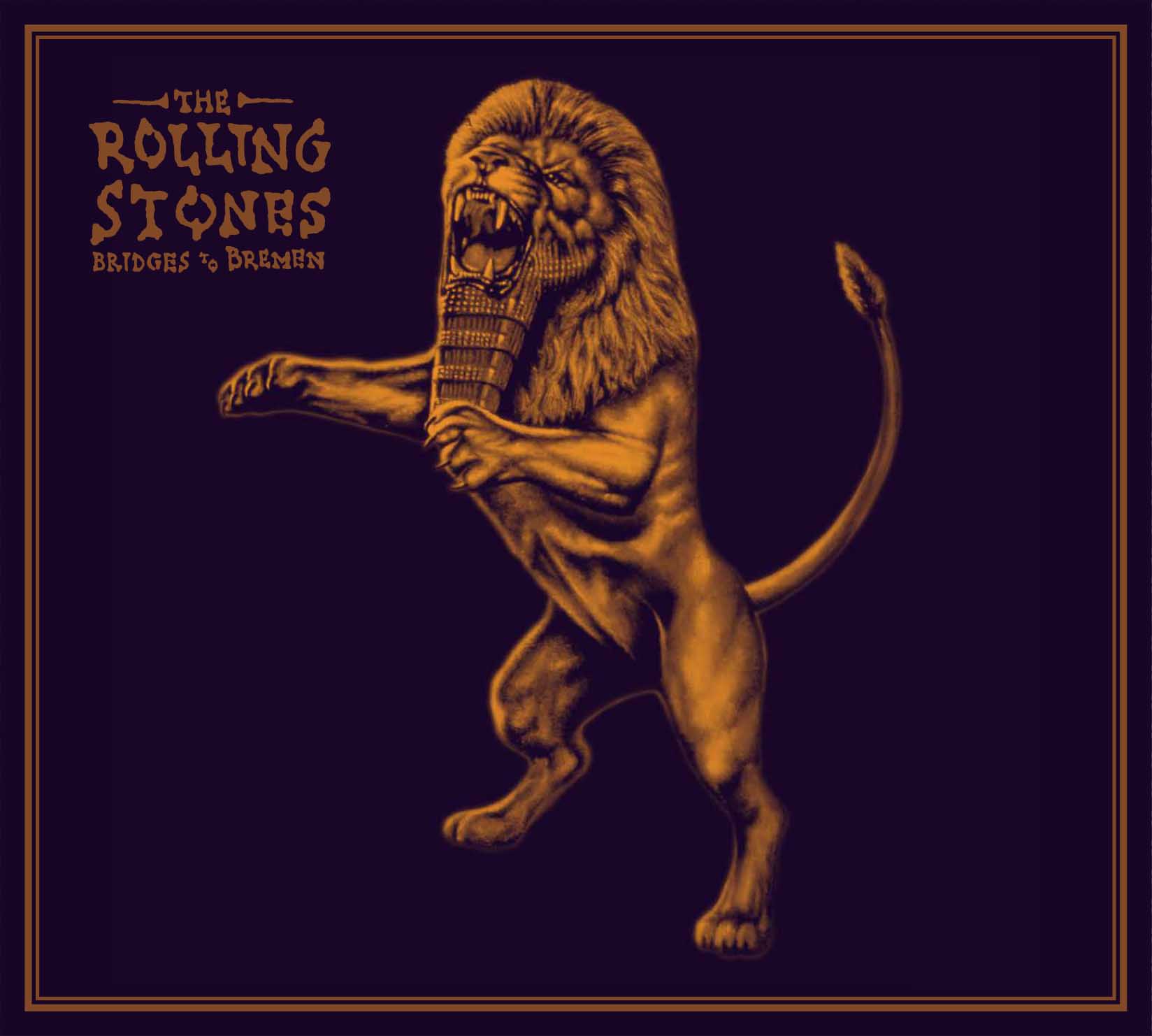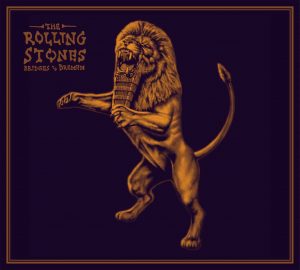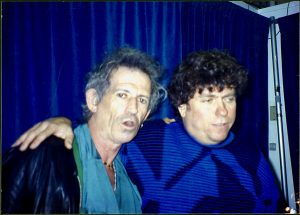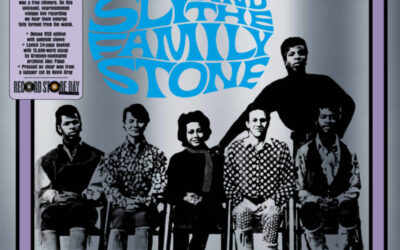CONCERT FILM TO BE RELEASED JUNE 21ST 2019
RESTORED, REMIXED AND REMASTERED SHOW LIVE FROM GERMANY
PREVIOUSLY UNRELEASED CONCERT PLUS FOUR BONUS TRACKS FROM CHICAGO;
KEITH RICHARDS 1999 INTERVIEW
By HARVEY KUBERNIK © 2019
As the Rolling Stones’ No Filter US tour dates are currently being re-scheduled Bridges To Bremen was announced today by the Rolling
Stones for release on June 21st.
Presented by Eagle Vision, the previously unreleased concert film has been completely restored, remixed and remastered and will be available on digital, DVD + 2CD, Blu-ray + 2CD, triple vinyl and digital audio formats.
Bridges to Bremen captures a complete September 2, 1998 show at Germany’s Weserstadion venue from the final leg of the Rolling Stones’ year-long trek that supported their Bridges to Babylon album, which achieved Platinum and Gold status in multiple markets upon the album’s original release in 1997.
The Bridges To Babylon tour was the first time the band went on the road with a permanent, and now infamous, B-stage, and also the first time that fans could vote on the band’s website for a track they wanted to hear at the show – “Memory Motel” in the case of the Bremen fans, making each show on the tour unique.
The Bridges To Babylon Tour lasted a year and was seen by over 4.5M fans, making it the (then) second highest grossing tour ever behind their (previous) Voodoo Lounge Tour three years earlier. The band performed 97 shows over 5 legs and 4 continents.
This concert film has been meticulously restored from the original masters, and the audio remixed and remastered from the live multitrack recordings. Four tracks from the band’s Soldier Field performances in Chicago are included as bonus features.
The release of Bridges To Bremen comes at a busy time for the band – Honk, a Best Of compilation featuring 36 essential Stones tracks from 1971 to 2016’s Blue & Lonesome (with the deluxe also featuring 10 live tracks recorded at stadiums around the world) is out on April 19th by Polydor.
On March 29th, Talk Is Cheap, Keith Richards’s debut solo album was released with six unheard session tracks in various retail formats.
The Stones’ 2019 US tour begins June 21st in Chicago, at Soldiers Field.
I caught several Bridges to Babylon gigs with Willapa band member David Kessel who helms www.cavehollywood.com. I asked the multi-instrumentalist to reflect on the 1999 California concerts he witnessed.
“I love the Stones and absolutely love Keith. He is rock ‘n’ roll. The blending of Chuck Berry and Buddy Holly with Chicago and Delta Blues is an incredible combination. Keith is a terrific band leader that glues the Stones together.
I’ve had the pleasure of being in the dressing room hang out area with Keith and Ronnie Wood. Keith actually asked ‘if I wanted something to drink,’ and I said ‘yeah, you got any beer?’ Keith replied ‘if I wanted Budweiser or Guinness.’ ‘I said Guinness.’ He insisted on going to their ice bucket and opening it for me. That’s a cool guy.
“This was on the Bridges To Babylon tour in L.A. I was invited to get into the Stones’ sound booth and stand behind their engineer and watch the whole show. A very different perspective of what’s happening on stage.
“I’ve seen the Stones several times, Dodger Stadium and San Jose as well, and I’m always amazed at the energy Keith and the band bring to the table.”
In 1999 I interviewed Keith Richards about the Bridges to Babylon tour and album of the same name as well as discussing his Wingless Angels album, reissued in a 2011 deluxe edition.
Portions of our conversation were in my book This Is Rebel Music: The Harvey Kubernik InnerViews published in 2004 by the University of New Mexico Press. Some quotes were culled from our interview published in Record Collector News magazine 2016. A few paragraphs appeared in my book 1967 A Complete Rock Music History of the Summer of Love. I’ve penned a new 2019 introduction.
PAPA IS A ROLLING STONE
KEITH RICHARDS
By Harvey Kubernik © 1999, © 2019
During 1997 the Rolling Stones recorded their album Bridges to Babylon at Ocean Way studios on Sunset Blvd in Hollywood and afterwards went on a tour.
A slew of their 1964-1966 classic albums had been recorded on this same street with producer and manager Andrew Loog Oldham at RCA Studios and 1968-1972 with producer Jimmy Miller at nearby Sunset Sound. Keith Richards and Mick Jagger d.b.a. The Glimmer Twins, along with Don Was were the executive producers on Bridges to Babylon.
I was invited to attend a handful of recording and vocal sessions.
I’ve always loved the sound of Ocean Way, formerly Western Recorders and United Western. The Beach Boys’ Pet Sounds was cut there with engineer Chuck Britz. Bing Crosby, Frank Sinatra, Ray Charles and Nat King Cole utilized United Western during the sixties.
Bones Howe engineered the Johnny Rivers 1964-1968 albums, the Mamas & The Papas efforts during 1965-1967, the 5th Dimension dates when he engineered and produced their hit singles, and in 1968 co-produced The Elvis Presley ’68 Comeback Special.
These Ocean Way rooms were designed by Allen Sides who purchased the United Western studio in 1984.
“The rooms hearken back to the era when you wanted a room that sounded good because people were playing real music in that room,” acknowledged producer Don Was in a 1999 interview we did.
“The main thing is that the reflections are good. You get good bleed-through in the mics. You want the good stuff to leak into the mics. Your walls have a major impact on that. Allen had the intelligence not to modernize the rooms for the sake of pleasing guys who do jingles. These rooms will sound good one hundred years from now.
“My favorite studio in the world is Studio 2, and that has a lot to do with the console. There are only two of these boards left in the world and they have a low end on them that’s really round and warm. It’s great to get it on your tracks. It’s a special board.”
At a Bridges To Babylon tracking date one late evening while Keith sang “How Can I Stop,” Was and I talked about his ability to convey a tune.
“He’s a great singer. He’s a great singer, man,” Was stressed. “He’s like Willie Nelson in the sense that Willie doesn’t differentiate between his guitar playing and his singing. He just shifts his performance from one instrument to another. Obviously, anyone who can play like Keith can communicate on an intense level. I think Keith is a sensitive guy. He’s tuned into shit that most people miss. He hears. He’s so quick and aware. He’s plugged into pain and he’s plugged into truth.
“My feeling is that personality extends far beyond the boundaries of the skin. You don’t have to spend much time in the room to realize that Keith’s personality is so huge that it fills a gigantic studio. If you could raise the ceiling up, he’d stand even taller. I don’t care where his skin ends. And, if you go see Mick Jagger on stage, you understand how far this guy projects. What I’ve discovered on this album is that Charlie Watts has a personality that looms as large as the other guys. He’s just simply more soft-spoken about it.
“Each guy has his own unique writing style. Mick can sit down with a pad of paper and a guitar and deliver a song. That’s not how Keith writes. Keith needs to play with other musicians and he hammers out a song by playing it over repeated sittings, with at least Charlie sitting behind the drums. Then he improvises stream of consciousness lyrics over a period of time, and culls from the best of those lyrics. So they’re two really different approaches.
“For example, when Mick is singing, his bone structure changes a little bit, his posture is different, and he starts to move, maybe takes the microphone off the stand and is holding the microphone. His voice hasn’t dropped, he’s got full use of the instrument and he’s a better singer than he was then. He looks basically the same, and when he comes to life and reveals himself, it’s thrilling. He’s as good a singer as you are ever going to find. He’s got an amazing gift for delivering personality to your doorstep. He can communicate on an emotional level so succinctly,” enthused Was.
“I will say that he has a thorough understanding of the emotional ‘beats’ in each song, and, like a great actor, knows how to reflect the truth of each line he sings. I don’t think it’s something you cultivate. You can certainly learn how to refine it but it’s just a gift. Same with Keith. When he stands up and does the moves while he’s playing the guitar, it just puts goose bumps on you.
“There’s a lot of improvisation, and this is a jazz band with just slightly different rhythms going on. They never play it the same way twice and it’s different all the time. Charlie Watts, just like (drummer) Tony Williams on Miles Smiles, has everyone just workin’ off his cymbals. If you listen to Charlie you will be entertained all night long! You will not even notice that five hours have gone by,” Don marveled.
“We were listening to a song, ‘How Can I Stop,’ and at the end we landed on this F sharp minor chord that was highly evocative of Coltrane’s A Love Supreme. Charlie is thrashing around the cymbals, and Blondie Champlin (piano) is playin’ something that evokes McCoy Tyner. Next thing, someone says, ‘Let’s put in some sax. Who’s the greatest sax player you know?’ In this instance, Rob Fraboni was engineering the session, and he’d worked on Wayne Shorter’s Native Dancer, so he just rang him up, and he was down the next day.”
At one session playback on a reggae-type number for Bridges To Babylon, “You Don’t Have To Mean It,” Stones’ musical associate, drummer and percussionist Jim Keltner gratefully remarked, “In every musician’s life, there are hopefully people who point you in the right direction musically. I’ve been blessed to have had Keith Richards be one of those people in my life. He’s one of the great late- night deejays of all time.”
One evening in a kitchen lounge, Jim, Keith and I talked about Eddie Cochran, Freddie Scott and particularly reggae music. As a music journalist I had encountered Peter Tosh, Bob Marley, Jacob Miller of the Inner Circle and conducted an interview with the Wailers in 1978.
I passed their joint audition and Keith quickly offered a chilled Vodka and cranberry juice on the rocks which I nursed for two hours. I was quite impressed learning that in 1970 and ’71 in England, Jim and Keith on weekends would hop into Richards’ luxurious motor vehicle searching out rare reggae records located in the UK Rasta community.
Over the subsequent years I insisted to both Keith and Jim that they really needed to make a visit to author and deejay Roger Steffens’ landmark Reggae Archive in Echo Park. The mission was accomplished this decade.
At a 1997 mix down inside Ocean Way, Keith touted a new recording he had just done with engineer Rob Fraboni in Jamaica, Wingless Angels a collection of five Nyabinghi Rastafarian drummers and Sister Maureen in drum, chant and vocal forum.
Richards also served as executive producer on Wingless Angels initially available on his own Mindless Records/Island Records label “I’ll talk to you ‘bout it when we (Stones) tour,” he guaranteed.
Arrangements were then made for a formal taped interview with Keith backstage before the Rolling Stones February 3, 1999 San Diego Bridges to Babylon tour date at Jack Murphy/Qualcomm Stadium.
I was re-introduced to him around a pre-show nosh with a few band members. When a freshly baked shepherd’s pie arrived I knew to ask Keith about an ancient Stones’ ritual where it was customary for Richards to break the crust before it was shared with rest of his group. “Go ahead, mate. Smash it! I’ve got me own pie now!”
Keith was delighted to discuss Wingless Angels and reflect on the second leg of the Stones’ Bridges to Babylon bookings. I saw several 1997 west coast appearances.
Incense burned in a small room with a couch and a chair as the only furniture. Marlboro cigarette butts filled ashtrays as the smoke surrounded us during our chat.
I was reminded that Keith as tyke in England during 1943-1945 of World War II had witnessed and felt the air raid bombs and missiles from German aircraft. He’d seen plenty of smoke, ash, rubble and ruins in his Dartford, Kent neighborhood, the most bombed out area in England. Growing up as a kid, Keith and the citizens of Britain were all on Ministry of Food ration booklets.
Young Keith Richards and his family recovering from the devastation of war, coupled with restrictions on available food might be a reason why as an adult he emerged with total freedom in life, within his rock ‘n’ roll band, during recording activities he wanted to do and playing music on stage.
Harvey Kubernik and Keith Richards 1999 Interview
HK: Let’s talk about The Rolling Stones.
KR: Surely.
Q: During the Bridges to Babylon tour I’ve seen both outdoor and indoor shows. The sound fills the stadium. How has the tour been going?
A: Fantastic, man. The stadium parts have been great. I’ve never known a tour to go . . . You kind of accept usually when you start a tour for it to have its high points and low points and you start to go for a happy medium, and hope there’s more high points than low. But this one is not like this. Very strange, but since Chicago, day one, the band and the sound, and the whole feel of it has gone on a steady upward plane. The graph looks amazing. As far as the band’s feeling good, I think it’s got a lot to do with the new sound system, and with Robbie McGrath, the mixer, has really got our live thing down. I mean we’ve got the guitars where we want them. But I think it’s a mixture of that and also the experience of the band.
Q: Did the Wingless Angels experience have an impact on the way you play with the Stones now on this concert tour?
A: I’m playing a little different on this (new) tour. Yea. I’m more conscious of dynamics. It’s exactly what it’s about. To make a record like the Wingless Angels, ‘Oh this is a great little pastime . . . a hobby’ when you’re doing it. You are not thinking in terms of that. But when you’ve finished it you realized that you’ve learned a whole lot about recording and music from like ten guys or so who live up in the hills in Jamaica and they’ve taught me, or re-taught me, or reminded me of like the spaces that can be left and that silence is your canvas and never forget it.
Q: And what about playing on the second stage? A smaller place right in the middle of the stadium for a set of tunes that I know really involves the audience.
A: It’s beautiful, great. It’s another thing. Once you’re on the stage it’s just some floor boards in spite of it. And you’re not really aware of everything you are seeing. But what really keeps tours going and alive for the band and therefore for the audience I think is to change it and to play the smaller joints indoors. And the small stage with the show. It’s necessary to change the scale sometimes. Otherwise you can really get used to the large thing. And you realize when you’re playing a small gig that you get dynamics back and you can re-translate that back to the big stage.
Q: When you and The Stones were recording Bridges To Babylon, did you know immediately that some of the songs would really work well in the live show. Like you now sing “Thief In The Night” in the set. “Out Of Control,” which is sort of Mick’s tune, really has become a show stopper.
A: With these new Mick songs, like the things done with The Dust Brothers, I like to get my hands on them live. We’ve rehearsed “Too Tight” as well. In a way, maybe when you write songs without even knowing it you’re kinda saying, “Can I do this live?” And so in a way you add that in. You don’t know if it’s gonna work, but I guess you keep in the back of your mind is “We’re making a record here. What happens if they all like it and we gotta play it live?” So in a way, that maybe in the back of the mind it sets up the song to be playable on stage.
Q: During the recent Stones’ Bridges To Babylon tracking sessions, I remember you and Rob talking to Charlie in the studio about applying some of the drum set ups you utilized during Wingless Angels to the Bridges To Babylon sessions. Like putting the front head back on the bass drum. Charlie Watts’ drum head.
A: Yea! I was working with Rob Fraboni, the same guy who recorded Wingless Angels, which was primarily recording their drums and voices, and you become particularly intent on getting them right, ya know. And the fact is there’s two heads on those drums and we figured out how to get a certain sound. Whereas in recording studios, 99 1/2 per cent of the time, the engineer will have the front head of the bass drum taken off, and they stuff cushions in it and they ram microphones down it, and actual fact, deadens the drum.
“That’s the easiest way to record a bass drum. And we wanted to record like a real bass drum. Charlie during Babylon was very receptive. “Can you do that? It’s been so many years since I’ve actually recorded with the skin on the front.
“There’s no doubt that while recording the Angels that a drum is a cylinder with two skins on either side, and that’s what really gives it a special sound. And I never realized that we were cutting like drummers, especially Charlie off from a whole half a drum. (laughs).
Q: How else did the Wingless Angels recording impact your recording activities as well as your work in the studio with The Stones?
A: With the Angels, I got very interested in ambient recording. The room is good if you know what you’re doing. Use as few microphones as possible. All the tinkering, splitting things up can never achieve. The whole idea when you play music is to fill the room with sound. You don’t have to pick up each individual instrument, particularly in order to do that. Because a band is several people playing something. And somewhere in the air of the room, that sound has to gather in one spot. And you have to find that spot. (smiles).
A: Do you like to write and record in Jamaica. I know the Stones’ Goat’s Head Soup was recorded there in 1973. I totally dig the guitars in “Heartbreaker” even though it’s out of tune with the electric piano. Maybe that’s the idea?
Q: (laughs). Yea. It’s very easy to write in Jamaica. I don’t find it difficult to write anywhere. But in Jamaica, it’s particularly easy because they are so musically oriented, the Jamaicans. I mean, to be quite honest with you, the Jamaicans do nothing without music, which for a musician is fantastic! Because, even if you’re not playing music in your own house, you can hear half the town below in little villages and there’s music playing. They do everything to music. It’s an open environment when we record. You can hear the rain on the recording.
“When you’re recording something as seemingly simple of just drums and voices, for the first few days microphone placement is very important. We’re trying different angles. You never point the microphone actually at the instrument. You’ve got them in the corners pointing and once you’ve found those placements, you don’t really change them. One of the joys of it was that you’re not really aware that you’re actually making a record. Yes you are recording but at the time I was recording it I had no particular outlet for it.
“I think because it’s timeless music. I mean, I’ve had African guys say, ‘This is more African than what is going on in Africa.’ I call it ‘marrow music.’ Not even bone music. It strikes to the marrow. It’s like a faint echo . . . The body responds to it and I don’t know why.
Q: For years I’ve been aware of Rob Fraboni’s engineering and producing. I know he did some work on Goat’s Head Soup in Los Angeles at Village Recorders. What attracts you to his board work?
A: He knows an awful lot, man, about recording. He knows a lot about microphones and I’ve worked with him off and on for 25 years. Many years we didn’t work together.
“You asked me earlier about Goat’s Head Soup. I was only really learning about Jamaica then and when you’re making records you’re pretty much myopic. And it was only really after recording Goat’s Head Soup and staying in Jamaica for several months, which was when I bumped into the Angels on the beach. And we got talking and playing. But in certain ways, Jamaica doesn’t change that much.
“There’s a very solid rhythm to life there, which they seem to be able to adapt to even incoming technologies that speed the rest of the world up. What I really love I think about Jamaica is that they have a rhythm all their own and everybody, including yourself after a few days you can’t get out of step, man, you know.
(Harvey Kubernik is an author of 15 books. His literary and music anthology Inside Cave Hollywood: The Harvey Kubernik Music InnerViews and InterViews Collection Vol. 1, was published in December 2017, by Cave Hollywood. Kubernik’s The Doors Summer’s Gone was published by Other World Cottage Industries in February 2018.
Harvey Kubernik’s The Doors: Summer’s Gone has been nominated for the 2019 Association for Recorded Sound Collections Awards for Excellence in Historical Recorded Sound Research.
During December 2018, Sterling/Barnes and Noble published Kubernik’s The Story of The Band From Big Pink to the Last Waltz.
This century Harvey penned the liner note booklets to the CD re-releases of Carole King’s Tapestry, Elvis Presley The ’68 Comeback Special, The Ramones’ End of the Century and Allen Ginsberg’s Kaddish.
In November 2006, Harvey Kubernik was a featured speaker discussing audiotape preservation and archiving at special hearings called by The Library of Congress and held in Hollywood, California).








